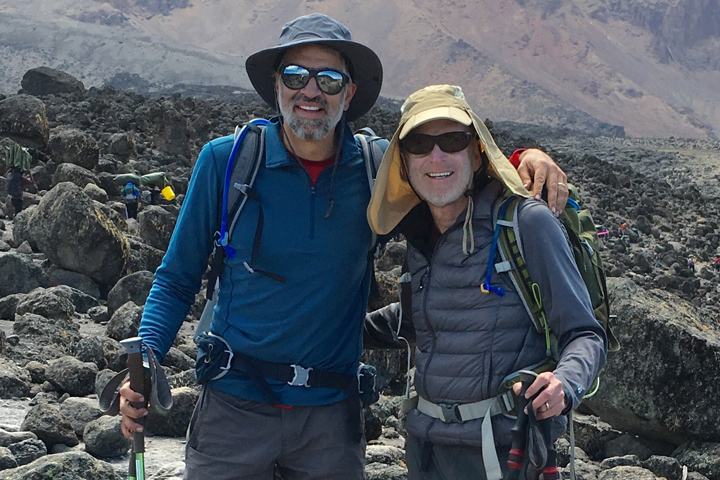Climbing the Pancreatic Cancer Mountain

- Getting second and third opinions after diagnosis
- Choosing neoadjuvant chemotherapy, surgery, and chemotherapy
- Climbing a world-famous mountain after recovery
January 8, 2019 marked my fifth anniversary of being cancer-free after pancreatic surgery.
I was 64 years old when I was diagnosed with pancreatic cancer. I was experiencing symptoms of itchiness, fatigue, and dark-colored urine. I attributed the symptoms to stress and dehydration. When I saw my doctor, blood tests showed an elevated bilirubin count. The likely diagnosis was a gallstone blocking my bile duct. I had an endoscopic study; when it was completed, I was given good news and bad news. The bad news was I had pancreatic cancer. The good news was that because the tumor was detected early and because of its location, I would be one of the 20 percent of pancreatic cancer patients eligible for the Whipple procedure. Although my first inclination was to find a cancer surgeon to immediately remove the tumor, I took a deep breath and scheduled appointments with a number of oncologists and cancer surgeons. I was amazed at the different opinions and treatment plans. One surgeon thought that my tumor might only be partially resectable because of its location involving an artery. Another doctor encouraged me to consider participating in a clinical trial that involved neoadjuvant chemotherapy (treatment before surgery) and radiation. I also received different opinions on the type of chemo. Some oncologists suggested FOLFIRINOX. Other oncologists advised that FOLFIRINOX was too toxic and suggested gemcitabine.
Choosing Doctors and Neoadjuvant Chemotherapy and Surgery
After reviewing my options I decided to get treated by oncologist Dr. Al Benson at Northwestern Memorial Hospital, in Chicago, and Dr. Malcolm Bilimoria at Northwest Community Healthcare, Arlington Heights, Illinois. On the advice of Dr. Benson, I elected to have neoadjuvant chemotherapy for two months utilizing FOLFIRINOX. I think this was my most important decision—to have chemo before surgery. The concern with chemo before surgery is that the side effects may delay surgery or allow the tumors to spread. But more than one doctor recommended chemo before surgery. Following the treatment, I had the Whipple surgery with Dr. Bilimoria as planned. After recovering from surgery, I completed the remaining four months of chemo and have remained cancer free since then.
Life After Pancreatic Cancer
Here is what I learned from my journey:
- Listen to your body and do not ignore symptoms. Most people are reluctant to visit doctors. I am alive today because I sought medical help when my body was literally “flashing red warning lights” in many different ways.
- Get second (and even third) opinions. It is important to find experienced doctors. Every surgeon I interviewed had excellent reputations with different experience in performing the Whipple procedure. But Dr. Bilimoria performs hundreds of Whipple surgeries each year while most surgeons only do 20 or 30. I believe that I am still alive today because of my diligence in finding Dr. Bilimoria and Dr. Benson.
- Participate in clinical trials. It may seem ironic that I am encouraging people to participate in clinical trials, when I chose not to become a participant. I did not participate in a trial because of Dr. Bilimoria’s confidence that the tumor was fully resectable and could be removed without chemo or radiation before surgery (although I did choose to have chemotherapy before surgery). However, clinical trials are essential in the fight against cancer. Protocols that are developed through clinical trials eventually become the standard method of treatment. I believe that neoadjuvant chemotherapy and the use of FOLFIRINOX has become a common treatment protocol with very encouraging results.
- Spread awareness. Pancreatic cancer survival rates are only going to change through research and new diagnosis and treatment options. Whether you are a patient, family member, or want to honor the memory of a family member or friend, I encourage you to get involved in spreading awareness or fundraising efforts. It can be as simple as making a donation to the pancreatic cancer organization of your choice, participating in the many cancer walks that occur throughout the country, or sharing your own story with Let’s Win. I walk every year in different events. It is gratifying to see all the participants who are trying to make a difference and embody the inspirational slogan that “No cancer patient walks alone.”
A pancreatic cancer diagnosis does not have to be a death sentence. My life has improved since my diagnosis. I now focus on what is important and recognize that each day is a blessing. While I suffer from side effects, I refuse to let the symptoms interfere with activities that bring me joy. In fact, having pancreatic cancer allowed me to fulfill a goal: to hike Mt. Kilimanjaro in Tanzania, Africa. I accomplished that goal in 2017 when I was invited to hike Mt. Kili with Dr. Bilimoria! With the help of organizations like Let’s Win, hopefully more people will have inspirational stories to share as they climb their own personal mountain.






